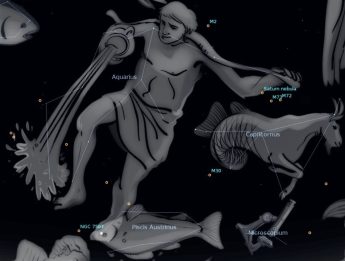This Week’s Sky at a Glance, 2025 Sept 27 – Oct 4
This Week’s Sky at a Glance, 2025 Sept 27 – Oct 4
Aquarius the Water Bearer is the source of all the water associated with our southern autumn constellations. It is situated among Pisces to the east and Capricornus to the west, with Pegasus north and Pisics Austrinus south. Its western end stretches over top of Capricornus. Most of the stars of Aquarius are relatively dim but one asterism stands out, the tight group of four stars that forms the Water Jar. Resembling a circle with three spokes, this asterism is also called the Steering Wheel.
One tale from mythology has Aquarius representing Ganymede, the handsome son of a Trojan king. Zeus was attracted to the lad and sent his pet eagle to kidnap him. Ganymede was given the important position of cup bearer (wine pourer) at Olympian feasts. There may have been another motive for the kidnapping; the moons of the planet Jupiter are named for Zeus’s lovers and Ganymede is the largest of those moons.
A few Messier objects lie within Aquarius, the best being the globular cluster M2. I usually star hop to this one by going from a star in the neck of Pegasus to its ear, and extending that line an equal distance. A fainter globular cluster, M73, is above the back of Capricornus, and just to its east is enigmatic M73. Stargazers wonder how this four-star asterism made it to the Messier list.
This Week in the Solar System
Saturday’s sunrise in Moncton is at 7:12 and sunset will occur at 7:06, giving 11 hours, 54 minutes of daylight (7:17 and 7:11 in Saint John). Next Saturday the Sun will rise at 7:21 and set at 6:52, giving 11 hours, 31 minutes of daylight (7:26 and 6:58 in Saint John).
The Moon is near Antares this Saturday evening and it is at first quarter on Monday. Saturn is low in the east during evening twilight, later displaying its edge-on rings for telescope users. Mars and Mercury are very low in the west after sunset, difficult targets for binocular viewing. By midweek Jupiter will be rising a half hour past midnight, placing it high in the east near Castor and Pollux for optimal morning observing. Venus rises around 5 am this weekend and a few minutes later each morning afterward. Have you ever seen a dwarf planet? Ceres, the largest body in the asteroid belt, is a binocular object in Cetus to the lower left of Saturn. Use the map in the Heavens-Above website to locate it.
Tune in to the Sunday Night Astronomy Show at 8 pm on the YouTube channel and Facebook page of Astronomy by the Bay. The Saint John Astronomy Club meets in the Rockwood Park Interpretation Centre on October 4 at 7 pm.

